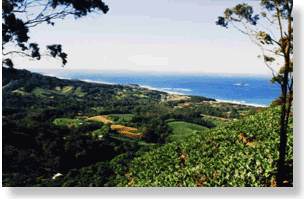
| Bruxner - view from Bruxner Park - opened by the Queen in 1965 - some people have this for the view from their dining room! |
|
|
A coastal area on the 30th Parallel of Latitude, roughly halfway between Brisbane (427km) and Sydney (535km). It is populated mostly by city folks, (90% of whom live on the coastal strip) attracted because it's not too hot and not too cold. With 51km of beaches, 960km² in area (that's 96000ha!), 57% is covered by forest. (Including 19ha in the Botanic Gardens - established 1981) There is an additional 3600ha in Dorrigo National Park and nextdoor to the North, the Yuragir National Park stretches for 60km along the coastline up to Angourie near Yamba In the Tasman is the Solitary Islands Marine Park - last of the warm water and home to both warm and temperate varieties. |